Submitted:
23 October 2024
Posted:
24 October 2024
You are already at the latest version
Abstract
Keywords:
1. Introduction
2. Materials and Methods
2.1. Study Area
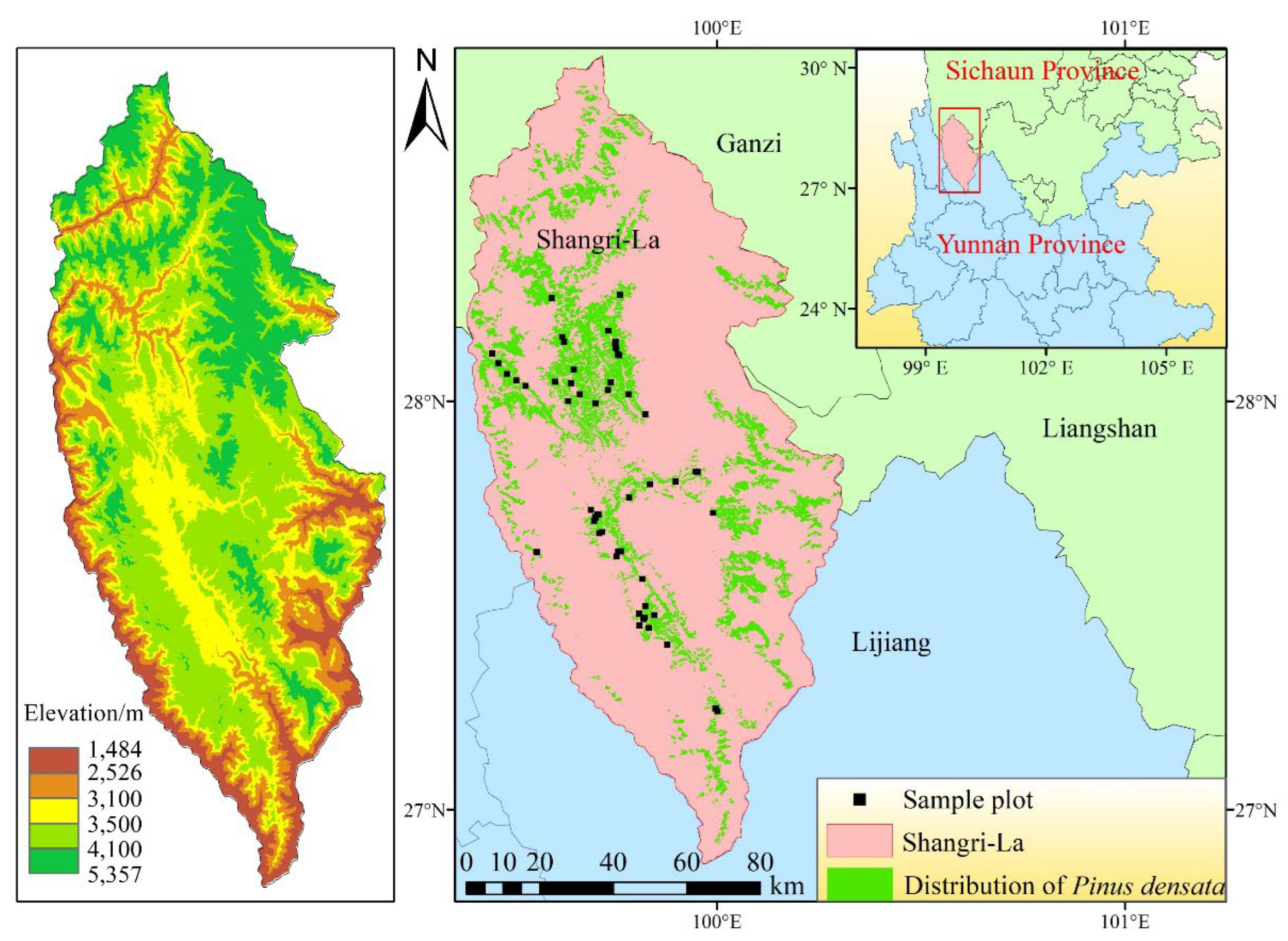
2.2. Technical Route
2.3. Data Source and Processing
2.3.1. Remote Sensing Data
2.3.2. Sample Plots
2.3.3. Topography Data
2.3.4. Climate Data
2.4. Factors Extraction and Combination
2.4.1. Factors Extraction
2.4.2. Factors Selection and Combination
2.5. Model Establishment and Evaluation
3. Results
3.1. Modeled by Remote Sensing Factors
3.2. Modeled Adding Topographic Factors
3.3. Modeled Adding Climatic Factors
3.4. AGCS Mapping
4. Discussion
4.1. Application of Remote Sensing Data Combination in Forest AGCS/AGB Estimation
4.2. Advantages in Model Accuracy from Sentinel-2A
4.3. Importance of Climatic Factors
5. Conclusions
Author Contributions
Funding
Data Availability Statement
Conflicts of Interest
References
- FAO, 2020. Global Forest Resources Assessment 2020 – Key findings. Rome. [CrossRef]
- Han, Y.; Li, X.; Luo, X. Estimation of above-ground carbon storage in the Jiufengshan National Forest Park of Wuhan based on GF-2 images. Geol. Bull. China. 2024, 43, 611–619. [Google Scholar] [CrossRef]
- Cohen, R.; Kaino, J.; Okello, J.; Bosire, J.; Kairo, J.; Huxham, M.; Mencuccini, M. Propagating uncertainty to estimates of above-ground biomass for Kenyan mangroves: A scaling procedure from tree to landscape level. For. Ecol. Manage. 2013, 310, 968–982. [Google Scholar] [CrossRef]
- Main-Knorn, M.; Cohen, W.B.; Kennedy, R.E.; Grodzki, W.; Pflugmacher, D.; Griffiths, P.; Hostert, P. Monitoring coniferous forest biomass change using a Landsat trajectory-based approach. Remote Sens. Environ. 2013, 139, 277–290. [Google Scholar] [CrossRef]
- Lu, T.; Qin, Y.; Xu, T.; Lang, X.; Yuan, Q.; Sun, L.; Shi, K. Remote Sensing Model of Aboveground Biomass of Pinus yunnanensis Forestin Central Yunnan Based on Mixed Effect Model. J. Northwest For. Univ. 2024, 04, 138–146. [Google Scholar] [CrossRef]
- Li, K.; Hu, Z.; Liu,P.; Xu, Z. Estimation of forest aboveground biomass in the Pearl River Delta based on Landsat-8 Oli remote sensing image data. J. Cent South Univ. For. Technol. 2023, 03, 73-81. [CrossRef]
- Zheng, W.; Wu,Y.; Ou, G. Remote Sensing Estimation and Inversion of Biomass for Major Forest Types in Kunming Based on Landsat 8 OLI. J. Southwest For. Univ. (Nat. Sci.). 2023, 06,107-116. [CrossRef]
- Teng, C.; Zhang, J.; Chen, C.; Bao, R.; Huang, K. Above-ground biomass estimation of Pinus densata based on Landsat time series images and AHTC algorithm. J. Cent South Univ. For. Technol. 2024, 44, 41–52. [Google Scholar] [CrossRef]
- Zou, L.; Li, H.; Zhang, J.; Chen, J.; Yang, H.; Gong, Z. Inversion of aboveground biomass of saltmarshes in coastal wetland using remote sensing. Acta Ecol. Sin. 2023, 20, 8532–8543. [Google Scholar] [CrossRef]
- Zhang, J.; Zhu, Y.; Zhang, H.; Liu, J.; Dilixiati, B. Biomass estimation of natural forests in the Altay Mountains based on Landsat 8 remote sensing images. J. Cent South Univ. For. Technol. 2022, 06, 33–44. [Google Scholar] [CrossRef]
- Liu, Y.; Li, Z.; Wu, Y.; Lu, C.; Ou, G. Incorporating Stratification of Age Groups and Topography for Aboveground Biomass Estimation of Quercus spp. Forests and Pinus kesiyavar. langbianensis Forests in Xishuangbanna by Remote Sensing. J. West China For. Sci. 2023, 01, 147–155. [Google Scholar] [CrossRef]
- Zhao, Y.; Xu, D.; Fan, K.; Li, S.; Shen, B.; Shao, C.; Xin, X. Estimating above-ground biomass in grassland using Landsat 8 and machine learning in Mongolian Plateau. Trans. Chin. Soc. Agric. Eng. 2022, 24, 138–144. [Google Scholar] [CrossRef]
- Zhou, R.; Zhao, T.; Wu, F. Aboveground biomass model based on Landsat 8 remote sensing images. J. Northwest For. Univ. 2022, 02, 186–192. [Google Scholar] [CrossRef]
- Zhao, Y.; Hou, M.; Feng, Q.; Gao, H.; Liang, T.; He, J.; Qian, D. Estimation of aboveground biomass in Menyuan grassland based on Landsat 8 and random forest approach. Acta Prataculturae Sin. 2022, 07, 1–14. [Google Scholar] [CrossRef]
- Misra, G.; Cawkwell, F.; Wingler, A. Status of phenological research using Sentinel-2 data: A review. Remote Sens. 2020, 12, 2760. [Google Scholar] [CrossRef]
- Yan, H.; Jiang, X.; Wang, W.; Wu, Z.; Liu, F.; Wen, Y. Aboveground biomass inversion based on Sentinel-2 remote sensing images in Chongli district. J. Cent South Univ. For. Technol. 2024, 44, 53–61. [Google Scholar] [CrossRef]
- Muhe, S.; Argaw, M. Estimation of above-ground biomass in tropical afro-montane forest using Sentinel-2 derived indices. Environ, 2022. [Google Scholar] [CrossRef]
- Pandit, S.; Tsuyuki, S.; Dube, T. Estimating Above-Ground Biomass in Sub-Tropical Buffer Zone Community Forests, Nepal, Using Sentinel 2 Data. Remote Sens. 2018, 10. [Google Scholar] [CrossRef]
- Guerini, M.; Kuplich, T.M.; De Quadros, F.L.F. Estimating natural grassland biomass by vegetation indices using Sentinel 2 remote sensing data. Int. J. Remote Sens. 2020, 41, 2861–2876. [Google Scholar] [CrossRef]
- Li, L.; Zhou, X.; Chen, L.; Chen, L.; Zhang, Liu, Y. Estimating Urban Vegetation Biomass from Sentinel-2A Image Data. For. 2020, 1. [CrossRef]
- Pang, H.; Zhang, A.; Kang, X.; He, N.; Dong, G. Estimation of the Grassland Aboveground Biomass of the Inner Mongolia Plateau Using the Simulated Spectra of Sentinel-2 Images. Remote Sens. 2020, 12. [Google Scholar] [CrossRef]
- Jiang, F.; Deng, M.; Tang, J.; Fu, L.; Sun, H.; 2022. Integrating spaceborne LiDAR and Sentinel-2 images to estimate forest aboveground biomass in Northern China. Carbon Balance Manag. 2022, 17, 12. [CrossRef]
- Pan, L.; Sun, Y.; Wang, Y.; Chen, L.; Cao, Y. Estimation of aboveground biomass in a Chinese fir (Cunninghamia lanceolata) forest combining data of Sentinel-1 and Sentinel-2. J. Nanjing For. Univ. (Nat. Sci. Ed.). 2020, 44, 149–156. [Google Scholar] [CrossRef]
- Chen, Y.; Li, L.; Lu, D.; Li, D. Exploring Bamboo Forest Aboveground Biomass Estimation Using Sentinel-2 Data. Remote Sens. 2019, 11. [Google Scholar] [CrossRef]
- Liu, J.; Meng, X.; Gao, Y.; Wen, X.; Lin, G.; She, G.; Liu, X. Remote sensing estimation of pinestand biomass based on different site quality. J. Cent South Univ. For. Technol. 2016, 36, 41–46. [Google Scholar] [CrossRef]
- Meng, X.; Liu, X.; Gao, Y.; Liu, J.; Wen, X.; Lin, G.; Xu, D. Remote sensing estimation of different site-quality broadleaved forest carbon budget in Jiande, Zhejiang. J. Nanjing For. Univ. (Natural Sciences Edition). 2017, 41, 87–92. [Google Scholar] [CrossRef]
- Zhao, H.; Lei, Y.; Fu, L. Biomass and Uncertainty Estimates of Pinus massoniana Forest for Different Site Classes in Jiangxi Province. Sci. Silvae Sinicae 2017, 08, 81–93. [Google Scholar] [CrossRef]
- Liao, Y.; Zhang, J.; Bao, R.; Xu, D.; Han, D. Modelling the Dynamics of Carbon Storages for Pinus densata Using Landsat Images in Shangri-La Considering Topographic Factors. Remote Sens. 2022, 14, 6244. [Google Scholar] [CrossRef]
- Zhang, J.; Xu, H. Establishment of remote sensing based model to estimate the aboveground biomass of Pinus densata for permanent sample plots from national forestry inventory. J. Beijing For. Univ. 2020, 42, 1–11. [Google Scholar] [CrossRef]
- Han, D.; Zhang, J.; Yang, J.; Wang, S.; Feng, Y. Establishment of the remote sensing estimation model of the above-ground biomass of Pinus densata Mast.considering topographic effects. J. Cent South Univ. For. Technol. 2022, 42, 12–21. [Google Scholar] [CrossRef]
- Liao, Y.; Zhang, J.; Bao, R.; Xu, D.; Wang, S.; Han, D. Estimation of aboveground biomass dynamics of Pinus densata by considering topographic factors. Chin. J. Ecol. 2023, 42, 1243–1252. [Google Scholar] [CrossRef]
- Cao, J.; Zhang, J.; Wang, F.; Han, X.; Huang, Y. Estimation and Uncertainty Analysis of Aboveground Carbon Storage of Pinus densata based on Random Forests and Monte Carlo. For.Res. 2023, 05, 131–139. [Google Scholar] [CrossRef]
- Wu, J.; Ou, G.; Shu, Q. Remote sensing estimation of the biomass of Pinus kesiya var. langbianensis forest based on BP neural networks. J. Cent South Univ. For. Technol. 2017, 07, 30–35. [Google Scholar] [CrossRef]
- Xu, Z.; Shu, Q.; Yang, K.; Wu, J.; Zhang, Y. A Study on Biomass Model of Pinus densata Forest Based on Nonlinear Mixed Effects. Acta Agric. Univ. Jiangxiensis 2017, 01, 101–110. [Google Scholar] [CrossRef]
- Peng, S.; Zhao, C.; Zheng, X.; Xu, Z.; He, L. Spatial distribution characteristics of the biomass and carbon storage of Qinghai spruce (Picea crassifolia) forests in Qilian Mountains. Chin. J. Appl. Ecol. 2011, 22, 1689–1694. [Google Scholar] [CrossRef]
- Xu, T.; Shu, Q.; Ou, G.; Xu, H. Spatial differentiation characters of carbon storage for Pinus kesiya var.langbianensis plantations in Jinggu County, China. J. Agric. Univ. Hebei. 2015, 38, 44–49. [Google Scholar] [CrossRef]
- Hao, L.; Zhang, T.; Li, X.; Xu, L.; Xie, T. Influence mechanism of land surface temperature to the forest aboveground biomass based on the Landsat 8 image. J. Cent South Univ. For. Technol. 2021, 41, 31–41. [Google Scholar] [CrossRef]
- Pongratz, J.; L. Bounoua, R. S. DeFries, D. C. Morton, L. O. Anderson, W. Mauser, and C. A. Klink. The Impact of Land Cover Change on Surface Energy and Water Balance in Mato Grosso, Brazil. Earth Interact. 2006, 10, 1–17. [CrossRef]
- Yin, T.; Zhang, J.; Liao, Y.; Wang, F.; Cao, J.; He, Y.; Chen, C.; Xiao, Q. Estimating the Pinus densata Carbon Storage of Shangri-La by Environmental Variables. J. West China For. Sci. 2024, 53, 119–128. [Google Scholar] [CrossRef]
- Jiang, F.; Kutia, M.; Ma, K.; Chen, S.; Long, J.; Sun, H. Estimating the aboveground biomass of coniferous forest in Northeast China using spectral variables, land surface temperature and soil moisture. Sci. Total Environ. 2021, 785, 147335. [Google Scholar] [CrossRef]
- Rosas-Chavoya, M.; López-Serrano, P.M.; Vega-Nieva, D.J.; Hernández-Díaz, J.C.; Wehenkel, C.; Corral-Rivas, J.J. Estimating Above-Ground Biomass from Land Surface Temperature and Evapotranspiration Data at the Temperate Forests of Durango, Mexico. For. 2023, 14, 299. [Google Scholar] [CrossRef]
- An, X.; Chen, C.; Zhang, D.; Wan, H.; Wu, Y.; Ma, L.; Tang, X.; Ou, Q. Source appointment of the influencing factors of carbon storage in Chinese fir plantations in the eastern part of the northern extreme of Chinese fir distribution. Chin. J. Ecol. 2023, 1–16. [Google Scholar]
- Cheng, X.; Lv, J. Mechanism of climate influence on carbon storage in the Tarim River Basin and attribution under topographic differentiation. Arid Zone Res. 2024, 1-13. /: 1-13. https.
- Gai, Z.; Zheng, W.; Wang, H.; Du, G. Spatio-temporal Pattern and Simulation of Terrestrial Ecosystem Carbon Storage in Black Soil Region under Climate Change. Trans. Chin. Soc. Agric. Mach. 2024, 06, 303–316. [Google Scholar] [CrossRef]
- Feng, W.; Wang, L.; Xie, J.; Yue, C.; Zheng, Y. Yu. Estimation of forest biomass based on muliti-source remote sensing data set–a case study of Shangri-La County. ISPRS Ann. Photogramm. Remote Sens. Spatial Inf. Sci. 2018, 4, 77–81. [Google Scholar] [CrossRef]
- Deng, Y.; Pan, J.; Wang, J.; Liu, Q.; Zhang, J. Mapping of Forest Biomass in Shangri-La City Based on LiDAR Technology and Other Remote Sensing Data. Remote Sens. 2022, 14, 5816. [Google Scholar] [CrossRef]
- Wang, J.; Chen, P.; Xu, S.; Wang, X.; Chen, F. Forest biomass estimation in Shangri-La based on the remote sensing. J. Zhejiang A & F Univ. 2013, 03, 325–329. [Google Scholar]
- Chen, P.; Wang, J.; Xu, S.; Chen, F.; Wang, X. A Study on Remote Sensing Information Model of Regional Forest Biomass. Remote Sens. Technol. Application. 2012, 05, 722–727. [Google Scholar]
- Bao, R.; Zhang, J.; Chen, P. Research on improving the accuracy of estimating aboveground biomass for Pinus densata based on remote sensing using filtering algorithm. J. Southwest For. Univ. (Nat. Sci.). 2020, 40, 126–134. [Google Scholar] [CrossRef]
- Li, L.; Zhou, B.; Liu, Y.; Wu, Y.; Tang, J.; Xu, W.; Wang, L.; Ou, G. Reduction in Uncertainty in Forest Aboveground Biomass Estimation Using Sentinel-2 Images: A Case Study of Pinus densata Forests in Shangri-La City, China. Remote Sens. 2023, 15, 559. [Google Scholar] [CrossRef]
- Chen, C.; He, Y.; Zhang, J.; Xu, D.; Han, D.; Liao, Y.; Luo, L.; Teng, C.; Yin, T. Estimation of Above-Ground Biomass for Using Multi-Source Time Series in Shangri-La Considering Seasonal Effects. For. 2023, 14. [Google Scholar] [CrossRef]
- Deng, Y.; Pan, J.; Wang, J.; Liu, Q.; Zhang, J. Mapping of Forest Biomass in Shangri-La City Based on LiDAR Technology and Other Remote Sensing Data. Remote Sens. 2022, 14, 5816. [Google Scholar] [CrossRef]
- Zhang, L.; Shao, Z.; Liu, J.; Cheng, Q. Deep Learning Based Retrieval of Forest Aboveground Biomass from Combined LiDAR and Landsat 8 Data. Remote Sens. 2019, 11, 1459. [Google Scholar] [CrossRef]
- Yue, C. Forest biomass estimation in Shangri-La County based on remote sensing. Doctor, Beijing Forestry University, Beijing, China, 2012.
- Tang, J.; Zhang, J.; Chen, L.; Cheng, T. Research on estimation of aboveground biomass and scale conversion for Pinus densata mast. For. Grassland Resour. Res. 2021, 83–89. [Google Scholar] [CrossRef]
- Sun, X. Biomass estimation model of Pinus densata forests in Shangri-La city based on Landsat8-OLI by remote sensing. Master, Southwest Forestry University, Kunming, China, 2016.
- Ding, Y.; Peng, S. Spatiotemporal Trends and Attribution of Drought across China from 1901-2100. Sustainability 2020, 12. [Google Scholar] [CrossRef]
- Peng, S. 1-km monthly mean temperature dataset for China (1901-2022). National Tibetan Plateau / Third Pole Environment Data Center. 2019. [CrossRef]
- Peng, S.; Ding, Y.; Liu, W.; Li, Z. 1 km monthly temperature and precipitation dataset for China from 1901 to 2017. Earth Syst. Sci. Data 2019, 11, 1931–1946. [Google Scholar] [CrossRef]
- Peng, S.; Ding, Y.; Wen, Z.; Chen, Y.; Cao, Y.; Ren, J. Spatiotemporal change and trend analysis of potential evapotranspiration over the Loess Plateau of China during 2011–2100. Agric. For. Meteorol. 2017, 233, 183–194. [Google Scholar] [CrossRef]
- Peng, S.; Gang, C.; Cao, Y.; Chen, Y. Assessment of climate change trends over the Loess Plateau in China from 1901 to 2100. Int. J. Climatol. 2018, 38, 2250–2264. [Google Scholar] [CrossRef]
- Peng, S. 1-km monthly precipitation dataset for China (1901-202). National Tibetan Plateau / Third Pole Environment Data Center. 2020. [CrossRef]
- Ding, Y.; Peng, S. Spatiotemporal change and attribution of potential evapotranspiration over China from 1901 to 2100. Theor. Appl. Climatol. 2021, 145, 79–94. [Google Scholar] [CrossRef]
- Peng, S.; 2022. 1 km monthly potential evapotranspiration dataset in China (1901-2022). National Tibetan Plateau / Third Pole Environment Data Center. [CrossRef]
- Hargreaves, G.; Samani, Z. (1985). Reference crop evapotranspiration from temperature. Appl. Eng. Agric. 1985, 1(2), 96–99. [Google Scholar] [CrossRef]
- Wang, J.; Cheng, P.; Xu, S.; Wang, X.; Cheng, F. Forest biomass estimation in Shangri-La based on the remote sensing. J. Zhejiang Agric. For Univ. 2013, 30, 325–329. [Google Scholar]
- Xie, F. Estimation and mapping of forest aboveground biomass based on k-NN model and remote sensing. Master, Southwest Forestry University, Kunming, China, 2019. [CrossRef]
- Liu, S.; Wang, X.; Zhao, F. Aboveground biomass estimation of oasis-desert transition zone vegetation based on Sentinel-2. J. Arid Land Resour. Environ. 2024, 38, 162–170. [Google Scholar] [CrossRef]
- Moradi, F.; Darvishsefat, A.A.; Pourrahmati, M.R.; Deljouei, A.; Borz, S.A. Estimating Aboveground Biomass in Dense Hyrcanian Forests by the Use of Sentinel-2 Data. For. 2022, 13, 104. [Google Scholar] [CrossRef]
- Chen, Y.; Li, L.; Lu, D.; Li, D. Exploring Bamboo Forest Aboveground Biomass Estimation Using Sentinel-2 Data. Remote Sens. 2019, 11, 7. [Google Scholar] [CrossRef]
- Purohit, S.; Aggarwal, S.P.; Patel, N.R. Estimation of forest aboveground biomass using combination of Landsat 8 and Sentinel-1A data with random forest regression algorithm in Himalayan Foothills. Trop. Ecol. 2021, 62, 288–300. [Google Scholar] [CrossRef]
- Zhou, Y.; Feng, Z. Estimation of Forest Stock Volume Using Sentinel-2 MSI, Landsat 8 OLI Imagery and Forest Inventory Data. For. 2023, 14, 1345. [Google Scholar] [CrossRef]
- Puliti, S.; Breidenbach, J.; Schumacher, J.; Hauglin, M.; Klingenberg, T.F.; Astrup, R. Above-ground biomass change estimation using national forest inventory data with Sentinel-2 and Landsat. Remote Sens. Environ. 2021, 265. [Google Scholar] [CrossRef]
- Ali, A.; Ullah, S.; Bushra, S.; Ahmad, N.; Ali, A.; Khan, M.A. Quantifying Forest carbon stocks by integrating satellite images and forest inventory data. Austrian J. for Sci. 2018, 135, 93–117. [Google Scholar]
- Huang, J.; Wu, J.; LI, C.; Qin, G.; Qian, J.; Li, H. Remote sensing retrieval of grassland above-ground biomass in Tianzhu county based on Sentinel-2 and Landsat 8 data. Acta Agrestia Sin. 2021, 29, 2023. [Google Scholar] [CrossRef]
- Luo, K.; Wei, Y.; Du, J.; Liu, L.; Luo, X.; Shi, Y.; Pei, X.; Lei, N.; Song, C.; Li, J.; Tang, X. Machine learning-based estimates of aboveground biomass of subalpine forests using Landsat 8 OLI and Sentinel-2B images in the Jiuzhaigou National Nature Reserve, Eastern Tibet Plateau. J. For. Res. 2022, 33, 1329–1340. [Google Scholar] [CrossRef]
- Liu,Y.; Liu, G.; Baiyila, D.; Cheng, W.; Chen, Z.; Jiang, L. Effects of Topographic Factors on Leaf Traits of Dominant Species in Different Forest Communities in Daqinggou Nature Reserves. Sci. Silvae Sinicae. 2017, 03, 154-162. [CrossRef]
- Li, H.; Han, H.; Da, A.; Wu, H. Biomass carbon distribution patterns of different Larix principis-rupprechtii plantations in Northern Shanxi and their relationship with climate factors. Chin. J. Appl. Environ. Biol. /: 14. https. [CrossRef]
- Zeng, W.; Pu, Y.; Yang, X.; Yi, S. Growth Models and Its Climate-Driven Analysis of Carbon Storage in Tree Layers of Five Major Plantation Types in China. Sci. Silvae Sinicae. 2023, 03, 21–30. [Google Scholar]
- David, H.; de Araújo, E.; Morais, V.; Scolforo, J.; Marques, J.; Netto, S.; MacFarlane, D. Carbon stock classification for tropical forests in Brazil: Understanding the effect of stand and climate variables. For. Ecol. Manage. 2017, 404, 241–250. [Google Scholar] [CrossRef]
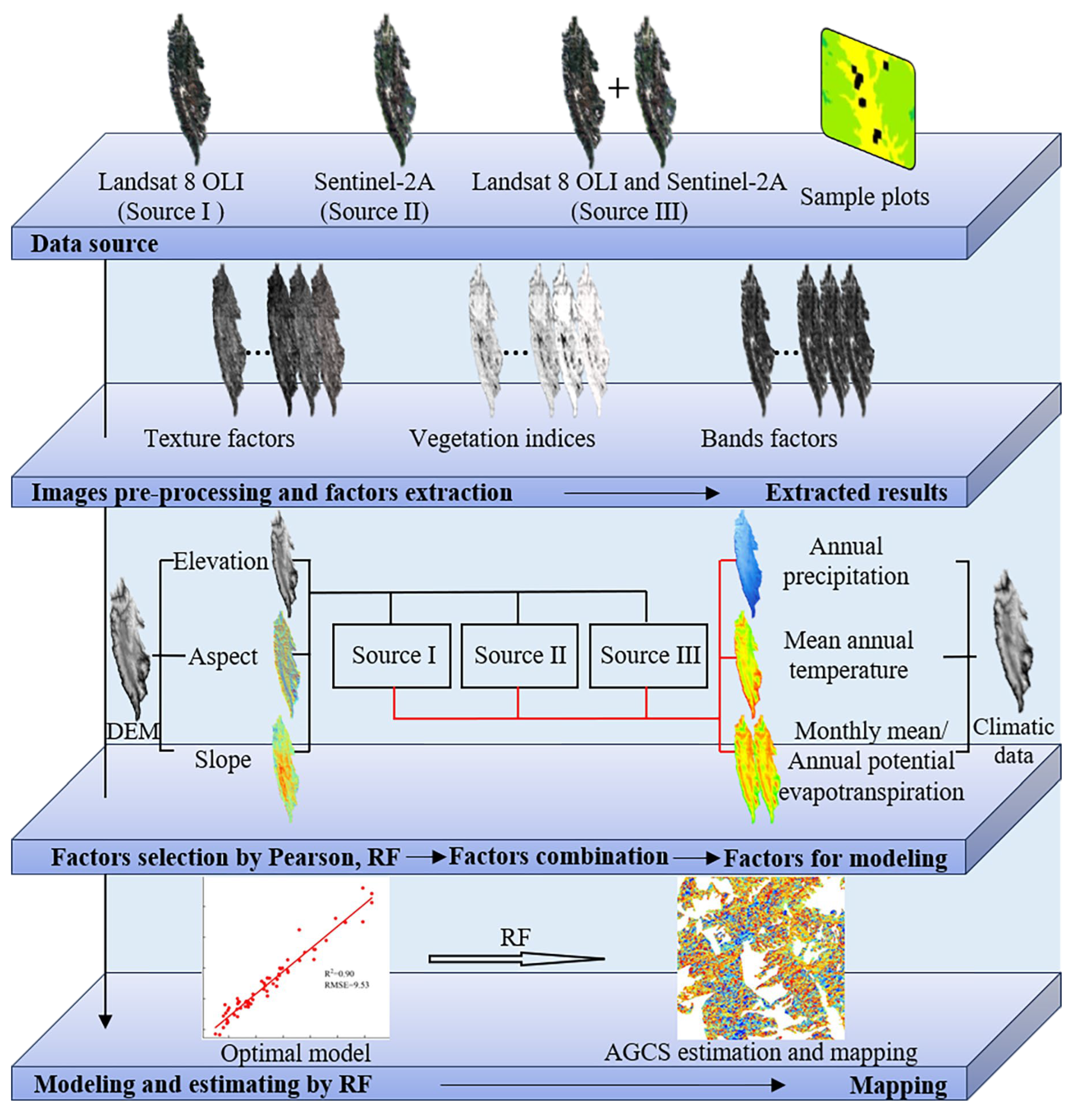
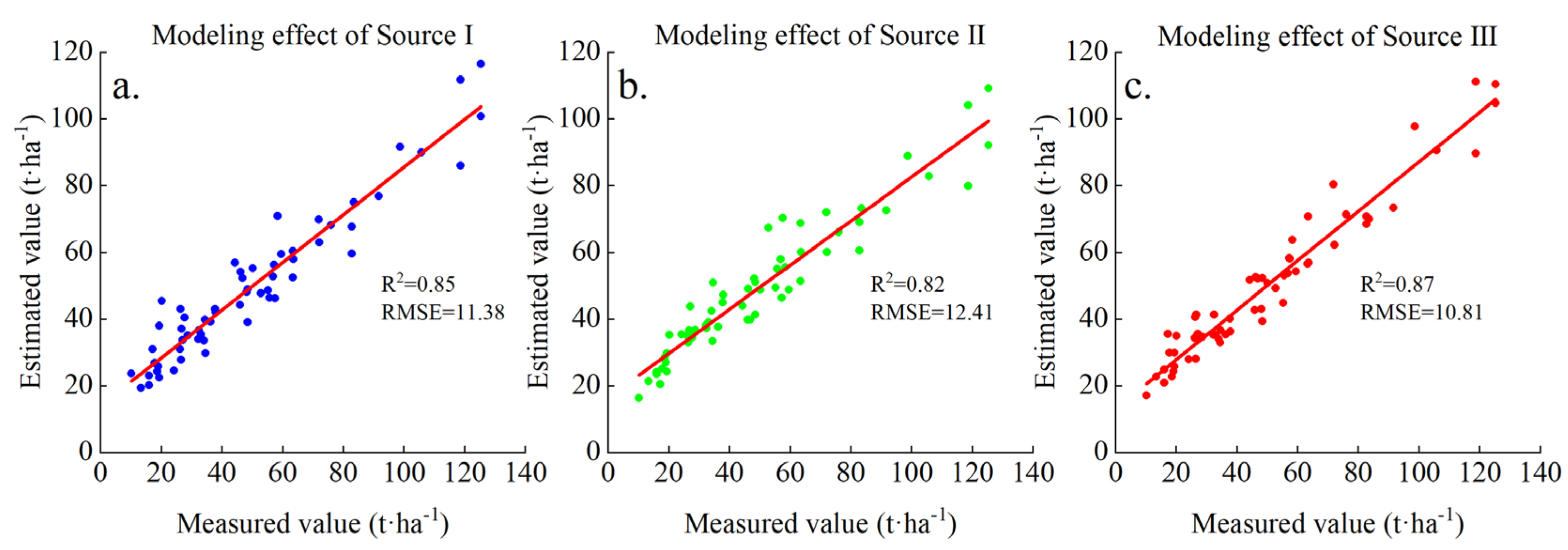
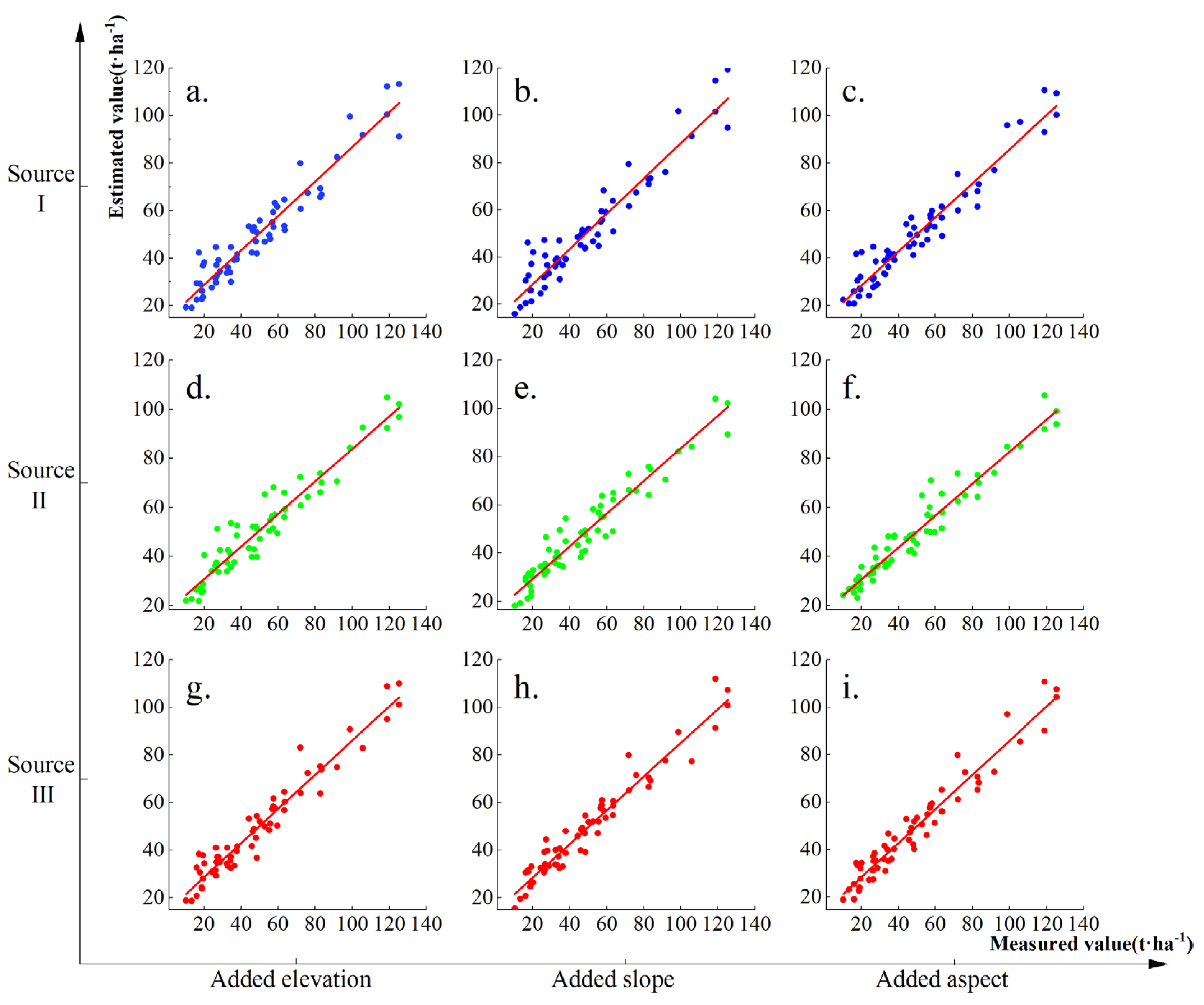
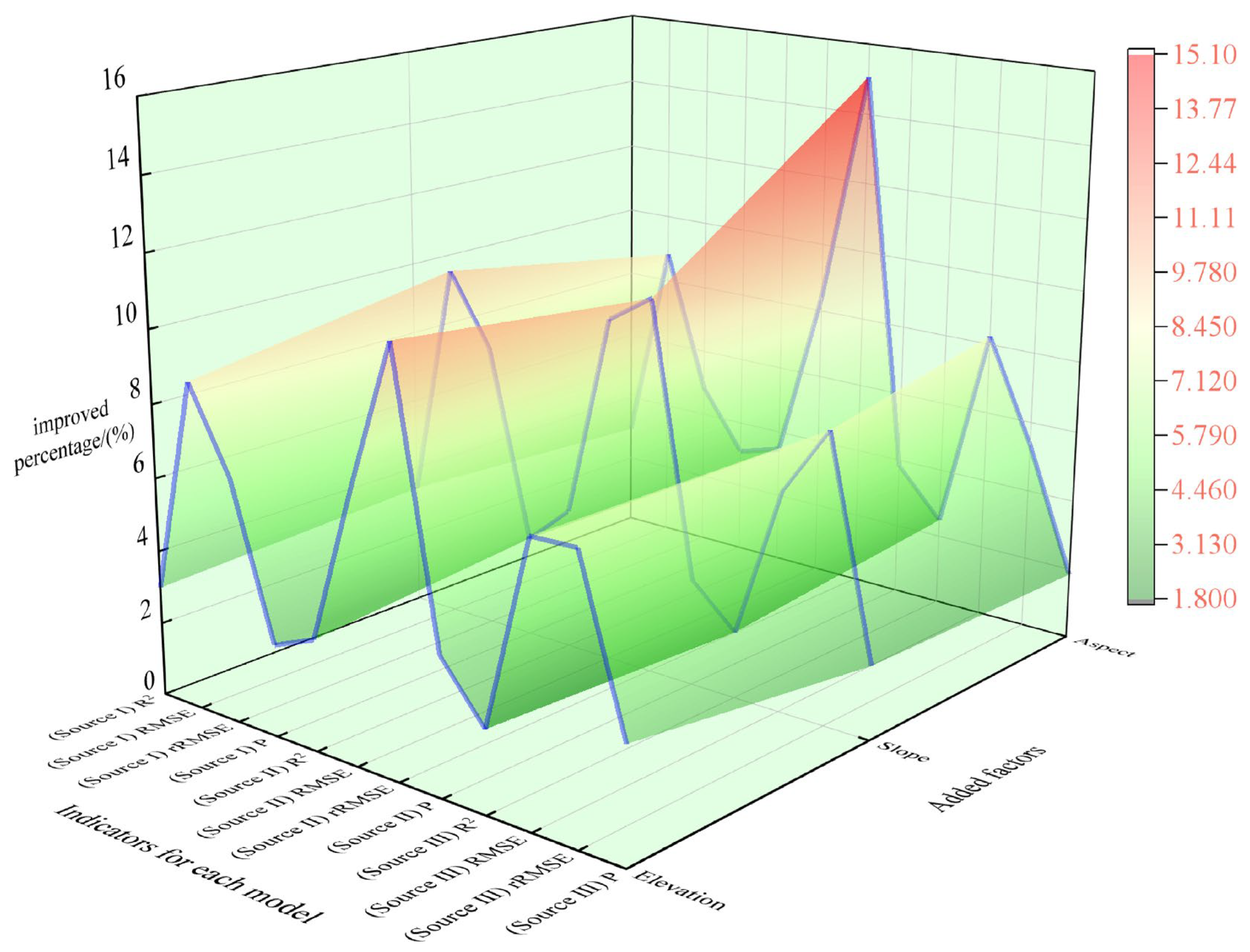
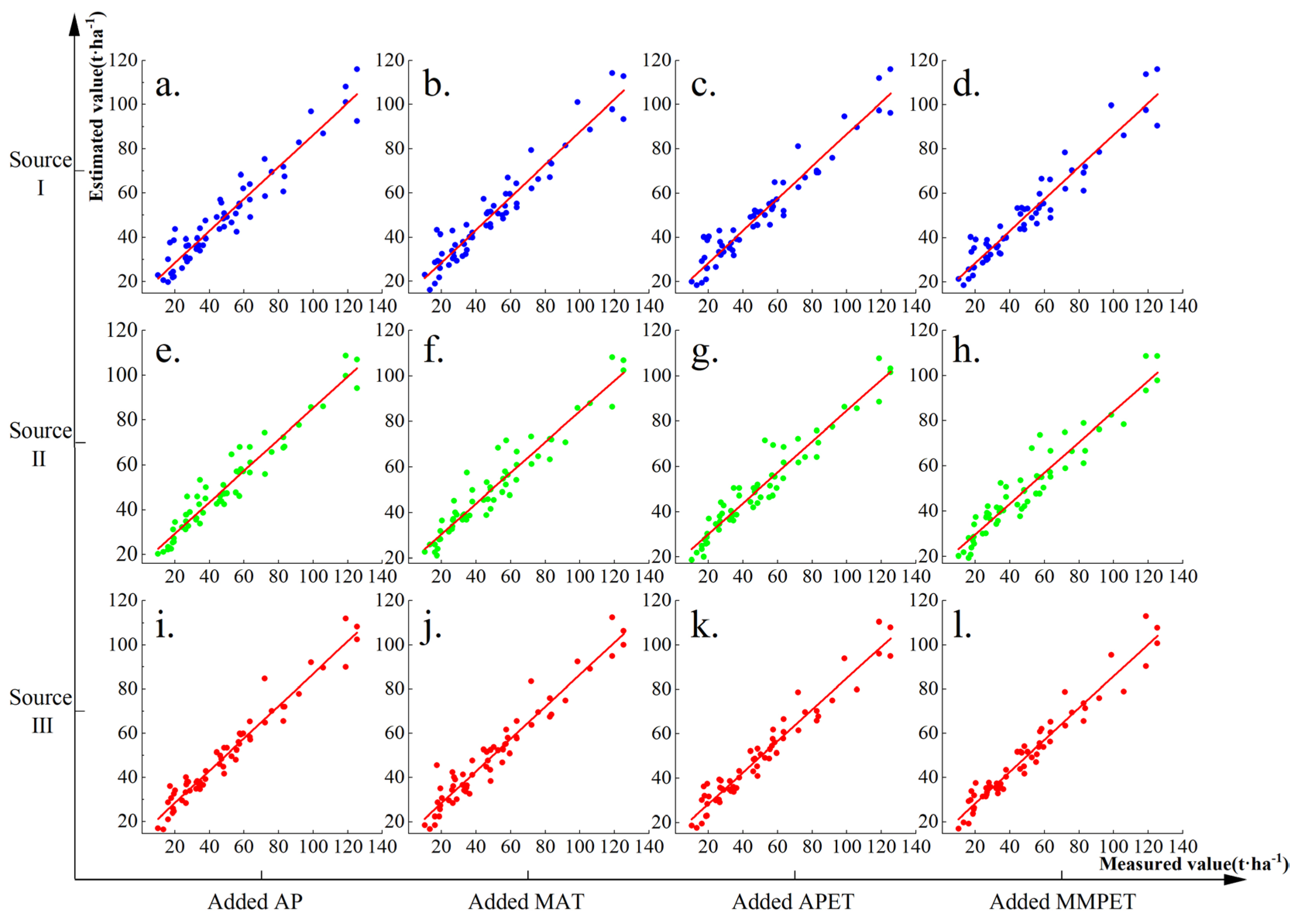
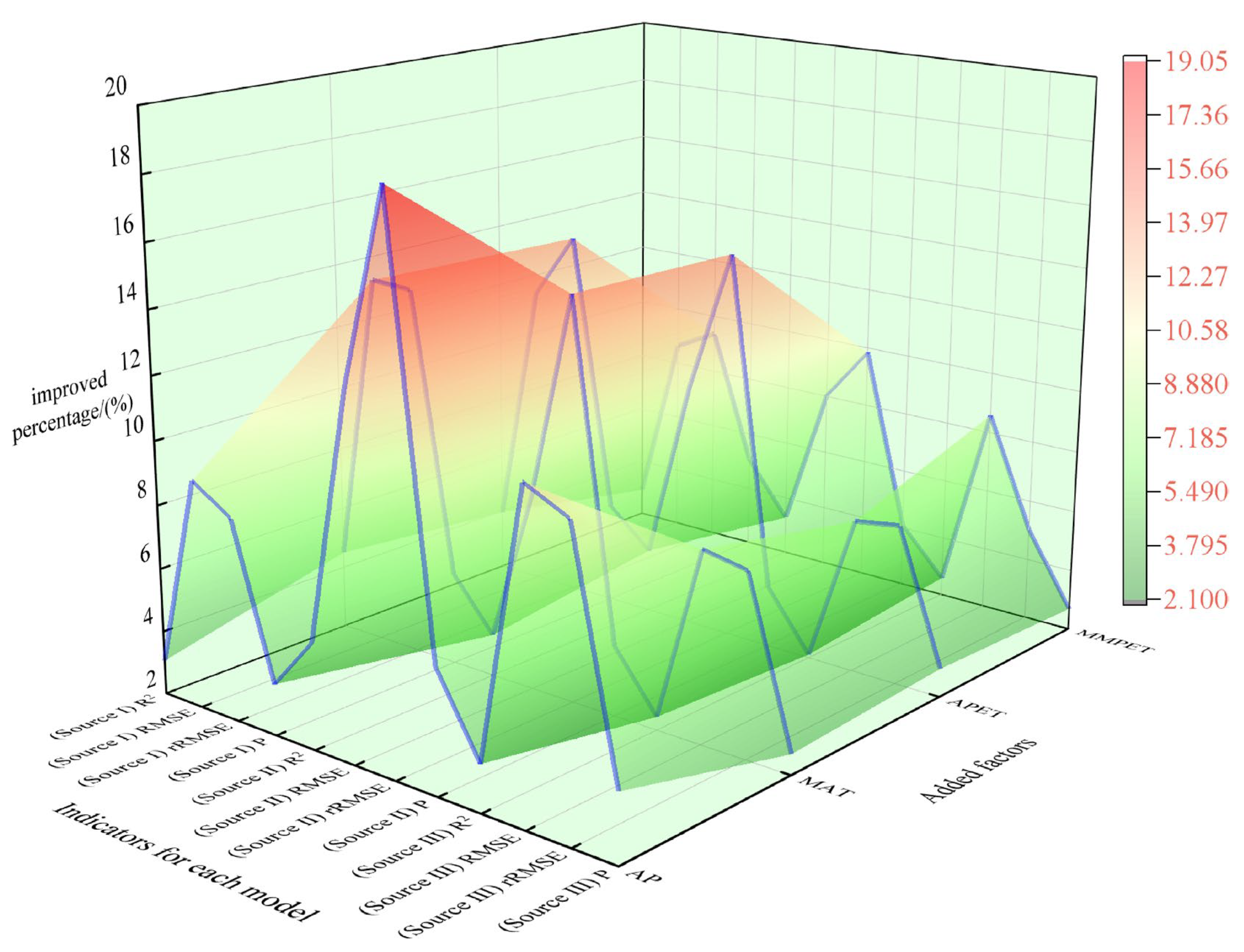
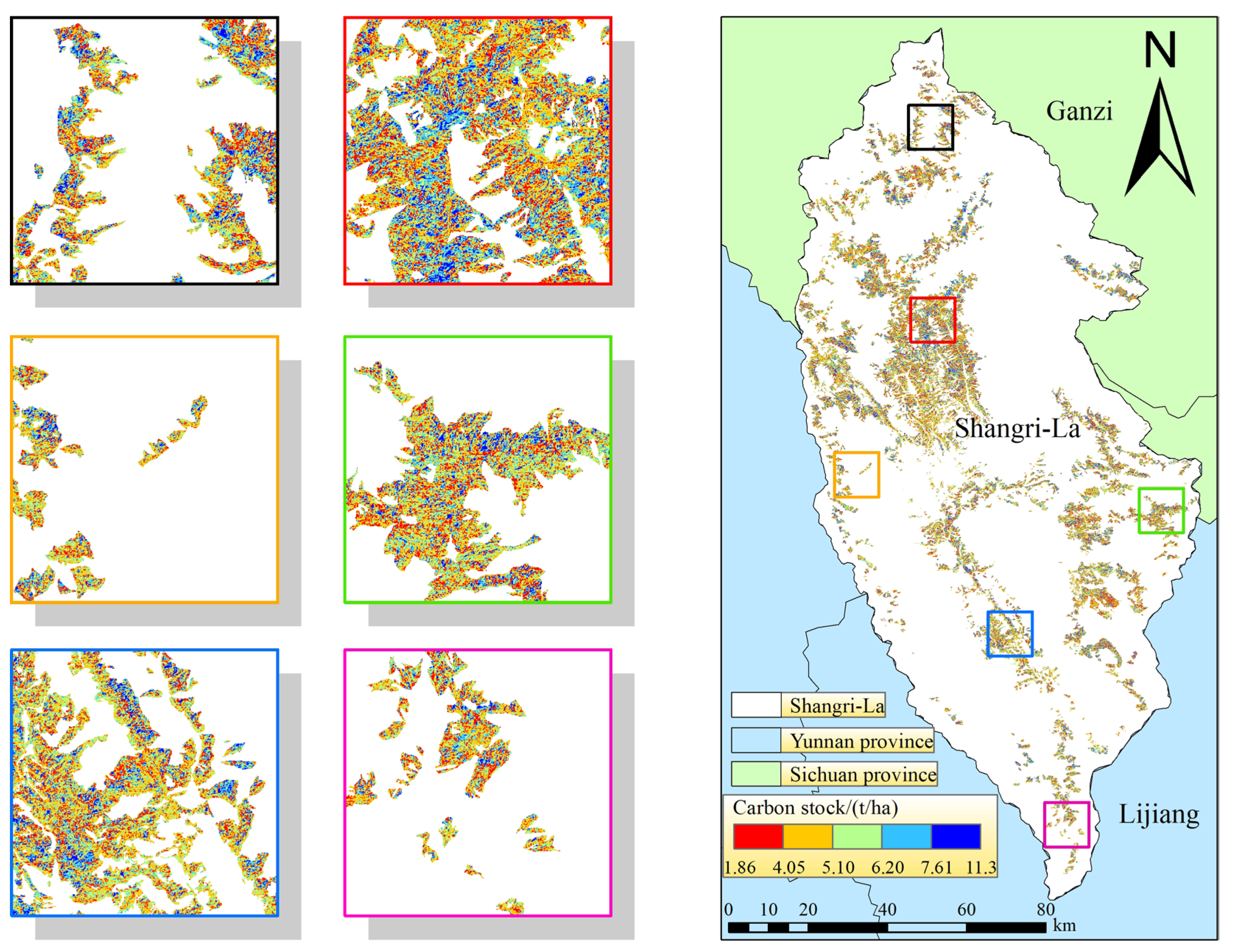
| Image type | Image ID | Cloud amount/(%) | |
|---|---|---|---|
| Landsat 8 OLI | LC81310412021082LGN00 | 0.88 | |
| LC81320412021313LGN00 | 0.58 | ||
| LC81320402021313LGN00 | 0.89 | ||
| Sentinel-2A | S2A_MSIL2A_20211108T035951_N0500_R004_T47RNM_20230103T171747.SAFE | 0.04 | |
| S2A_MSIL2A_20211118T040041_N0500_R004_T47RNK_20230101T032435.SAFE | 0.05 | ||
| S2A_MSIL2A_20211118T040041_N0500_R004_T47RNL_20230101T032435.SAFE | 0.00 | ||
| S2A_MSIL2A_20211118T040041_N0500_R004_T47RPK_20230101T032435.SAFE | 0.17 | ||
| S2A_MSIL2A_20211118T040041_N0500_R004_T47RPL_20230101T032435.SAFE | 0.01 | ||
| S2A_MSIL2A_20211218T040201_N0500_R004_T47RPM_20221225T151243.SAFE | 0.00 | ||
| Types | Factors | Source |
|---|---|---|
| Topographic factors and Band factors | Elevation, Slope, Aspect B1~B7/B1~B9, B11, B12 B53, B64, B65, B67, B74, B547, B4/Albedo | DEM, Landsat 8 OLI and sentinel-2A |
| Texture factors | (HO)homogeneity, (DI)dissimilarity, (ME)mean, (SM)angular second order moments, (EN)entropy, (CC)correlation, (VA)variance, (CO)contrast | Landsat 8 OLI and sentinel-2A |
| vegetation indices factors | NDVI, TNDVI, RVI, SAVI, TSAVI, MASAVI, MSAVI2, GEMI, IPVI, EVI, IRECI, MCARI, MTCI, REIP, NDI45, PSSRa. | Landsat 8 OLI and sentinel-2A |
| Climatic factors | mean annual temperature, annual precipitation, annual potential evapotranspiration, monthly mean potential evapotranspiration | National Tibetan Plateau Science Data Center |
| Data type | Source of data | Selected factors |
|---|---|---|
| Source I | Landsat 8 OLI | LR11B6CC, LR11B5CC, LR11B7CC, LR11B6SM, LR11B7SM |
| Source II | Sentinel-2A | SR5B8ASM, PSSRa, SR11B5SM, SR7B6CC, SR5B6CC, SR9B5SM, SR11B8ACC, SR5B1CC |
| Source III | Landsat 8 OLI and Sentinel-2A | LR11B5CC, LR11B6CC, LR11B5SM, LR11B7CC, LR7B6CC, LR9B6CC, SR5B6CC, SR5B8ASM, SR7B6CC, SR11B5SM, PSSRa |
| Data source | Model | R2 | RMSE/(t·ha-1) | rRMSE/(%) | P/(%) |
|---|---|---|---|---|---|
| Source I | Model 1 | 0.85 | 11.38 | 23.46 | 78.71 |
| Source II | Model 2 | 0.82 | 12.41 | 24.21 | 79.74 |
| Source III | Model 3 | 0.87 | 10.81 | 23.19 | 79.71 |
| Data source | Added factors | Model | R2 | RMSE/(t·ha-1) | rRMSE/(%) | P/(%) |
|---|---|---|---|---|---|---|
| Source I | Elevation | Model 4 | 0.88 | 10.37 | 21.90 | 80.67 |
| Slope | Model 5 | 0.88 | 10.24 | 21.57 | 80.92 | |
| Aspect | Model 6 | 0.88 | 10.38 | 22.33 | 81.14 | |
| Source II | Elevation | Model 7 | 0.85 | 11.51 | 21.49 | 82.70 |
| Slope | Model 8 | 0.86 | 11.22 | 21.69 | 82.10 | |
| Aspect | Model 9 | 0.85 | 11.37 | 20.56 | 82.80 | |
| Source III | Elevation | Model 10 | 0.89 | 10.01 | 21.47 | 82.17 |
| Slope | Model 11 | 0.88 | 10.156 | 21.34 | 81.33 | |
| Aspect | Model 12 | 0.89 | 9.92 | 21.95 | 81.18 |
| Data source | Added factors | Model | R2 | RMSE/(t·ha-1) | rRMSE/(%) | P/(%) |
|---|---|---|---|---|---|---|
| Source I | AP | Model 13 | 0.88 | 10.34 | 21.51 | 81.54 |
| MAT | Model 14 | 0.89 | 9.81 | 20.24 | 82.59 | |
| APET | Model 15 | 0.89 | 10.02 | 20.16 | 82.83 | |
| MMPET | Model 16 | 0.88 | 10.40 | 21.26 | 82.70 | |
| Source II | AP | Model 17 | 0.88 | 10.77 | 19.60 | 84.42 |
| MAT | Model 18 | 0.85 | 11.40 | 20.66 | 83.11 | |
| APET | Model 19 | 0.86 | 11.18 | 20.69 | 82.91 | |
| MMPET | Model 20 | 0.85 | 11.41 | 21.83 | 83.00 | |
| Source III | AP | Model 21 | 0.90 | 9.53 | 20.59 | 83.00 |
| MAT | Model 22 | 0.89 | 9.95 | 21.39 | 81.82 | |
| APET | Model 23 | 0.88 | 10.07 | 21.54 | 82.03 | |
| MMPET | Model 24 | 0.89 | 9.88 | 22.02 | 81.85 |
| Data year | AGB value/million tons | AGCS value/million tons | Source |
|---|---|---|---|
| 2008 | 16.67 | 8.64 | Yue [54] |
| 2009 | 20.00 | 10.02 | Wang et al. [66] |
| 2015 | 12.10 | 6.06 | Xie [67] |
| 2016 | 11.72 | 5.87 | Sun [56] |
| 1987-2017 | 8.50~9.16 | 4.26~4.59 | Liao et al. [31] |
| 1987-2017 | 11.55~16.54 | 5.78~8.29 | Teng et al. [8] |
| 2021 | 17.21 | 8.62 | Chen et al. [51] |
| 2021 | \ | 9.74 | This study |
Disclaimer/Publisher’s Note: The statements, opinions and data contained in all publications are solely those of the individual author(s) and contributor(s) and not of MDPI and/or the editor(s). MDPI and/or the editor(s) disclaim responsibility for any injury to people or property resulting from any ideas, methods, instructions or products referred to in the content. |
© 2024 by the authors. Licensee MDPI, Basel, Switzerland. This article is an open access article distributed under the terms and conditions of the Creative Commons Attribution (CC BY) license (http://creativecommons.org/licenses/by/4.0/).





